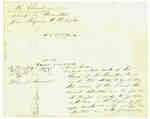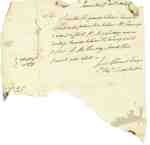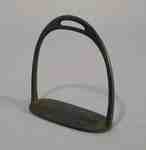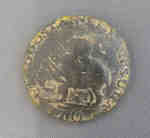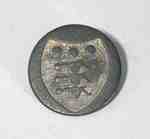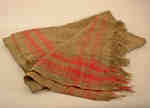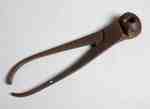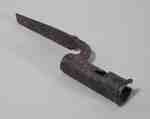Résultats
- This document is the war loss claim of Capt. H.S. Hart of the 1st Battalion, 82nd Regiment. He stated on November 2, 1814 that he lost 3 pairs of boots, 3 pairs of shoes, a brush, luggage and other sThis document is the war loss claim of Capt. H.S. Hart of …
- This document is a list of members of Captain John D. Servos' company of the First Lincoln Regiment Militia. It lists each soldier's name, and sometimes age, present or absent during roll call on DecThis document is a list of members of Captain John D. Servos' …
- This document is a diagram with explanations of the place where Sir Isaac Brock fell according to some who claim to have witness the event.This document is a diagram with explanations of the place where Sir …
- This document is the muster roll of Captain Servos Company of the 1st Regiment of the Lincoln militia from April 25, 1813 to May 24, 1813. The following are some of the names included: John D. ServosThis document is the muster roll of Captain Servos Company of the …
- This is a letter from Joseph Clement, Ensign of the 1st Regiment of the Lincoln Militia, concerning the guards located between the Queenston Camp and Corbin’s Inn. He stated that he visited them betwThis is a letter from Joseph Clement, Ensign of the 1st Regiment …
- A 1909 copy of an 1804 original plan of the lighthouse that was erected on Mississauga Point, signed by Gustavus Nicolls and copied by J. Simpson. The lighthouse, the first on the Great Lakes, was diA 1909 copy of an 1804 original plan of the lighthouse that …
- The book contains the standing orders of the Second York Regiment, dated 1799-1813. It is believed to have belonged to an officer at the Portsea Barracks in Britain. At this time, all officers were rThe book contains the standing orders of the Second York Regiment, dated …
- The notice, dated January 21, 1820, was sent by the Adjutant General's office to inform all officers, non-commissioned officers, and privates of the militia that they could apply for land grants fromThe notice, dated January 21, 1820, was sent by the Adjutant General's …
- A notice announcing land grant opportunities for those who served in the First Flank Companies, the Provincial Artillery, the Incorporated Regiment, the Corps of Artillery Drivers, the Provincial DraA notice announcing land grant opportunities for those who served in the …
- This document is a certificate appointing John Servos, Gentleman, as Ensign in the Lincoln Militia in Queenston on May 13, 1806, by Robert Hamilton, Lieutenant in the County of Lincoln.This document is a certificate appointing John Servos, Gentleman, as Ensign in …
- This iron stirrup features a flat base and an oval hole for a leather strap, so that is can be attached to a saddle. This stirrup was fashioned in 1812, so it is likely similar to those used by cavalThis iron stirrup features a flat base and an oval hole for …
- This button has a relief crown and field gun facing proper right. It is believed to be from the Royal Artillery and measures 2 cm in diameter.This button has a relief crown and field gun facing proper right. …
- This button is believed to have belonged to a member of the 76th Hindoostan Regiment that were in Niagara from 1812-1814.This button is believed to have belonged to a member of the …
- This is a brass military button that has a shield motif with three cannons and three cannon balls impressed on the face. There are also some traces of gilt remaining on the shield. It is believed thaThis is a brass military button that has a shield motif with …
- This photograph of a plan is titled “American Piquete Round Fort George Summer 1813". It was obtained by the Museum from the “National Archives of Canada, Cartographic and Architectural Archives DiviThis photograph of a plan is titled “American Piquete Round Fort George …
- This is an officer’s blanket that was owned by Col. John C. Ball during the War of 1812. It is also believed to have been used by Ball and Col. Merritt to carry and hide British ammunition undergrounThis is an officer’s blanket that was owned by Col. John C. …
- This is an American metal musket ball mold of a plier design, dated 1812-1814. It was used to press a musket ball to the size of a bore or rifle, approximately .69 calibre musket balls. The press endThis is an American metal musket ball mold of a plier design, …
- This musket, circa1812, with its ramrod attached, is a flintlock converted to a percussion steel firing mechanism. The barrel is steel and the stock is made of walnut. The marks include: the HanoveriThis musket, circa1812, with its ramrod attached, is a flintlock converted to …
- This is a bayonet socket with a portion of the blade attached that was discovered in the Niagara River. A bayonet is a steel blade that is designed to fit on the muzzle of a rifle or musket barrel, mThis is a bayonet socket with a portion of the blade attached …
- This is a fragment of a triangular bayonet blade, dated from the War of 1812-1814, that was discovered in the Niagara River. A bayonet is a steel blade that is designed to fit on the muzzle of a riflThis is a fragment of a triangular bayonet blade, dated from the …








